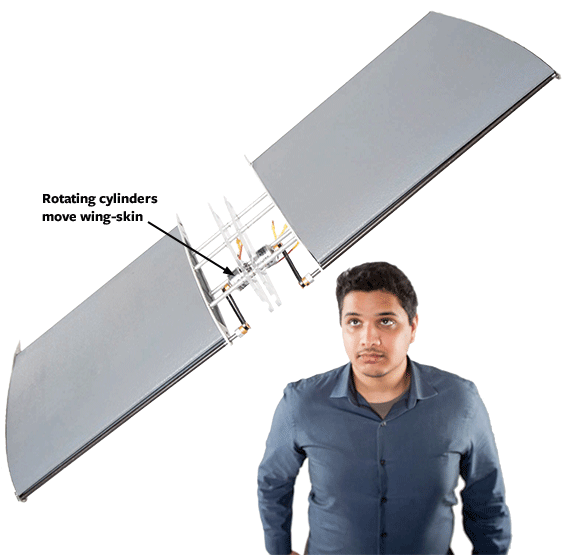Vires Aero
design team | Harshil Goel / Zachary Hargreaves / Jordan Greene
 Harshil Goel (Photo by Noah Berger)Summer jobs are as much a part of Berkeley’s undergraduate experience as dorm rooms and Tele-BEARS. For Harshil Goel, now a graduate student in mechanical engineering, the summer job he landed a few years ago changed his life — and maybe even the future of flight.
Harshil Goel (Photo by Noah Berger)Summer jobs are as much a part of Berkeley’s undergraduate experience as dorm rooms and Tele-BEARS. For Harshil Goel, now a graduate student in mechanical engineering, the summer job he landed a few years ago changed his life — and maybe even the future of flight.
As an undergraduate math major at Berkeley, Goel got a summer job at a wind tunnel in Kanpur, India. Often too hot to sleep at night, he pored over technical texts on aerodynamics on loan from his supervisor. One footnote, claiming that a certain type of aerodynamic control was not possible due to complexity, caught his attention, and he took it as a challenge. With his mathematics background and expertise in fluid dynamics, he developed an experiment to disrupt the boundary conditions and to prove this type of control was achievable. When he came up with a solution, he first thought, “This should make things better,” and then, “Has anyone ever done this?”
He built a proof of concept with strategically embedded rotating cylinders tangent to the surface of the wing. When he tested it in the wind tunnel, wing lift and stall characteristics improved dramatically. When he returned to campus, he joined up with EECS student Zachary Hargreaves and business major Jordan Greene; the team planted themselves in the machine shop in Etcheverry Hall to build more wings and unmanned aerial vehicles (UAVs) to further test the technology. They crashed a lot of models before finding the right set-up for a moveable wing-skin, which they call active circulation control.
Once deployed, the technology allows slower moving aircraft with shorter wings, like UAVs, to carry bigger payloads. If used on other vehicles, active circulation control could improve fuel efficiency. Goel is now co-founder and CEO of Vires Aeronautics Inc. The company has attracted the attention of venture capitalists, enabling the team to purchase time at a University of Washington wind tunnel to further refine the technology.

